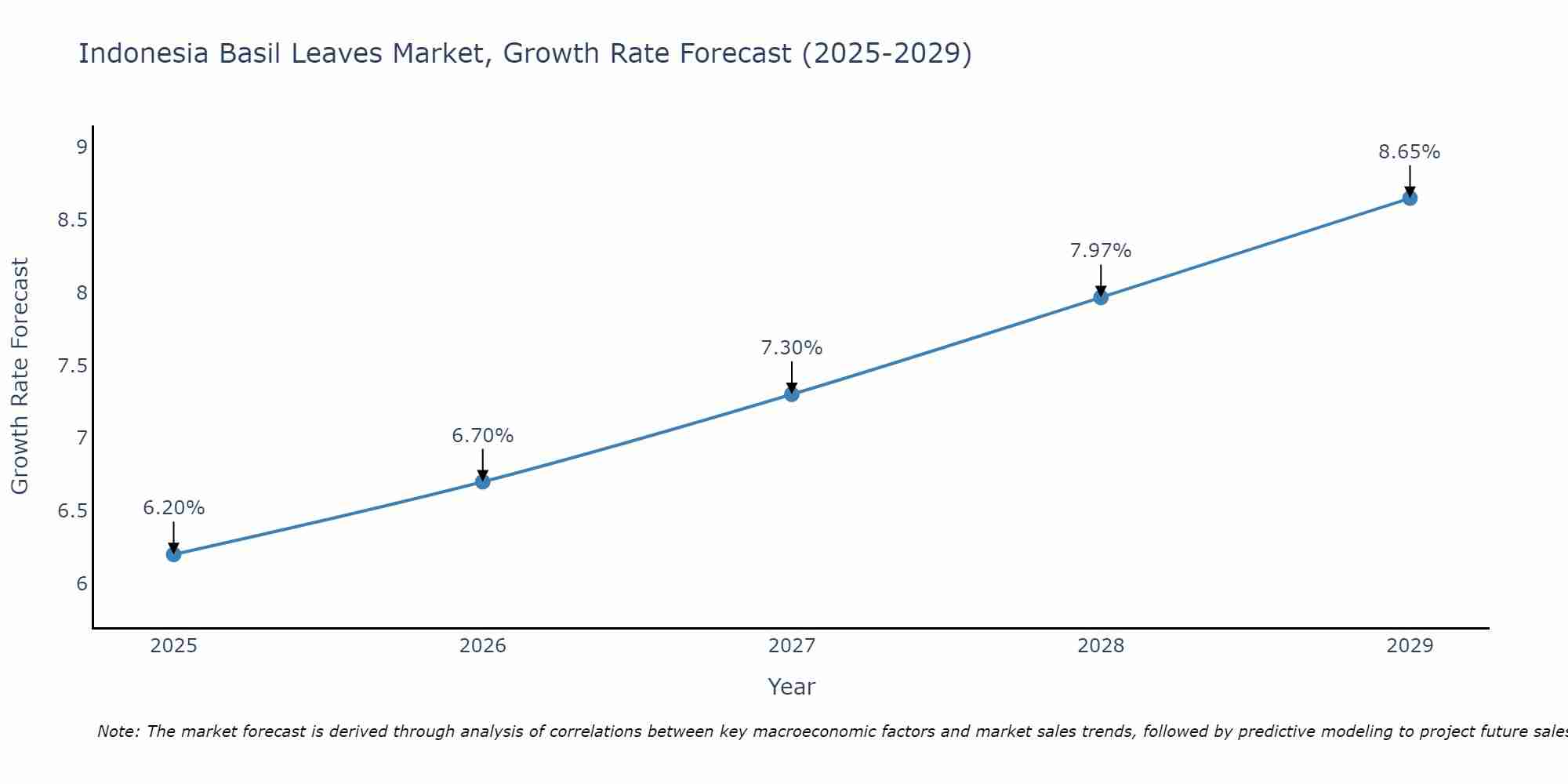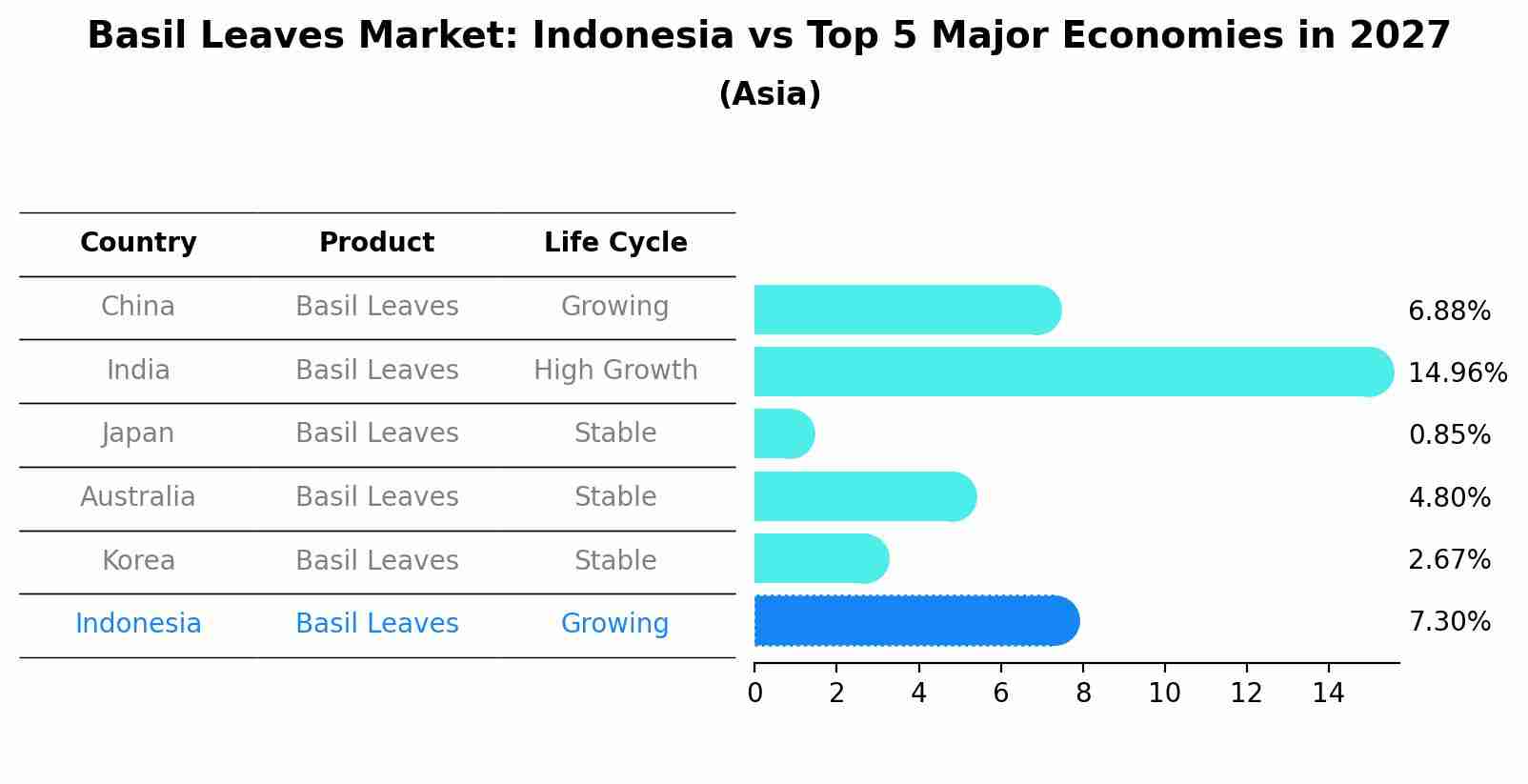Indonesia Basil Leaves Market (2025-2031) Outlook | Companies, Share, Industry, Revenue, Growth, Size, Analysis, Trends, Forecast & Value
| Product Code: ETC219208 | Publication Date: Aug 2023 | Updated Date: Aug 2025 | Product Type: Market Research Report | |
| Publisher: 6Wresearch | Author: Ravi Bhandari | No. of Pages: 75 | No. of Figures: 35 | No. of Tables: 20 |
Indonesia Basil Leaves Market Size Growth Rate
The Indonesia Basil Leaves Market is poised for steady growth rate improvements from 2025 to 2029. The growth rate starts at 6.20% in 2025 and reaches 8.65% by 2029.

Basil Leaves Market: Indonesia vs Top 5 Major Economies in 2027 (Asia)
The Basil Leaves market in Indonesia is projected to grow at a growing growth rate of 7.30% by 2027, within the Asia region led by China, along with other countries like India, Japan, Australia and South Korea, collectively shaping a dynamic and evolving market environment driven by innovation and increasing adoption of emerging technologies.

Indonesia Basil Leaves Market Synopsis
Basil leaves hold a special place in Indonesian cuisine, and their market outlook remains promising. Basil leaves are widely used in various traditional dishes, and with the thriving culinary industry, the demand for these aromatic leaves is set to increase. Additionally, the increasing popularity of herbal and natural remedies will further bolster the basil leaves market, as they are also valued for their medicinal properties.
Drivers of the Market
The basil leaves market in Indonesia is expected to grow steadily due to the widespread use of basil leaves in Indonesian cuisine and its increasing popularity in international dishes. Basil leaves are valued for their aromatic flavor and potential health benefits. The growing trend of using natural herbs and spices in food preparation is also contributing to the market`s positive outlook.
Challenges of the Market
The basil leaves market might face difficulties related to shelf life and preserving the flavor and aroma of the leaves. Proper post-harvest handling and processing are crucial to maintain product quality.
COVID-19 Impact on the Market
The basil leaves market faced challenges during the pandemic due to supply chain disruptions and fluctuations in demand from the foodservice industry. However, as the economy reopens, the demand for basil leaves is expected to stabilize. The popularity of fresh herbs in cooking and their perceived health benefits are likely to drive market growth.
Key Highlights of the Report:
- Indonesia Basil Leaves Market Outlook
- Market Size of Indonesia Basil Leaves Market, 2024
- Forecast of Indonesia Basil Leaves Market, 2031
- Historical Data and Forecast of Indonesia Basil Leaves Revenues & Volume for the Period 2021-2031
- Indonesia Basil Leaves Market Trend Evolution
- Indonesia Basil Leaves Market Drivers and Challenges
- Indonesia Basil Leaves Price Trends
- Indonesia Basil Leaves Porter's Five Forces
- Indonesia Basil Leaves Industry Life Cycle
- Historical Data and Forecast of Indonesia Basil Leaves Market Revenues & Volume By Product Type for the Period 2021-2031
- Historical Data and Forecast of Indonesia Basil Leaves Market Revenues & Volume By Basil Leaves for the Period 2021-2031
- Historical Data and Forecast of Indonesia Basil Leaves Market Revenues & Volume By Basil Paste for the Period 2021-2031
- Historical Data and Forecast of Indonesia Basil Leaves Market Revenues & Volume By Dried Leaves for the Period 2021-2031
- Historical Data and Forecast of Indonesia Basil Leaves Market Revenues & Volume By End Use for the Period 2021-2031
- Historical Data and Forecast of Indonesia Basil Leaves Market Revenues & Volume By Essential Oils for the Period 2021-2031
- Historical Data and Forecast of Indonesia Basil Leaves Market Revenues & Volume By Pharmaceutical for the Period 2021-2031
- Historical Data and Forecast of Indonesia Basil Leaves Market Revenues & Volume By Snacks for the Period 2021-2031
- Historical Data and Forecast of Indonesia Basil Leaves Market Revenues & Volume By Baked Foods for the Period 2021-2031
- Historical Data and Forecast of Indonesia Basil Leaves Market Revenues & Volume By Beverages for the Period 2021-2031
- Historical Data and Forecast of Indonesia Basil Leaves Market Revenues & Volume By Others for the Period 2021-2031
- Indonesia Basil Leaves Import Export Trade Statistics
- Market Opportunity Assessment By Product Type
- Market Opportunity Assessment By End Use
- Indonesia Basil Leaves Top Companies Market Share
- Indonesia Basil Leaves Competitive Benchmarking By Technical and Operational Parameters
- Indonesia Basil Leaves Company Profiles
- Indonesia Basil Leaves Key Strategic Recommendations
Frequently Asked Questions About the Market Study (FAQs):
1 Executive Summary |
2 Introduction |
2.1 Key Highlights of the Report |
2.2 Report Description |
2.3 Market Scope & Segmentation |
2.4 Research Methodology |
2.5 Assumptions |
3 Indonesia Basil Leaves Market Overview |
3.1 Indonesia Country Macro Economic Indicators |
3.2 Indonesia Basil Leaves Market Revenues & Volume, 2021 & 2031F |
3.3 Indonesia Basil Leaves Market - Industry Life Cycle |
3.4 Indonesia Basil Leaves Market - Porter's Five Forces |
3.5 Indonesia Basil Leaves Market Revenues & Volume Share, By Product Type, 2021 & 2031F |
3.6 Indonesia Basil Leaves Market Revenues & Volume Share, By End Use, 2021 & 2031F |
4 Indonesia Basil Leaves Market Dynamics |
4.1 Impact Analysis |
4.2 Market Drivers |
4.2.1 Growing consumer awareness about the health benefits of basil leaves |
4.2.2 Increasing demand for organic and natural ingredients in food products |
4.2.3 Rise in popularity of Indonesian cuisine globally |
4.3 Market Restraints |
4.3.1 Weather conditions affecting basil leaf cultivation |
4.3.2 Price fluctuations of basil leaves due to seasonal variations |
4.3.3 Competition from substitute herbs and spices |
5 Indonesia Basil Leaves Market Trends |
6 Indonesia Basil Leaves Market, By Types |
6.1 Indonesia Basil Leaves Market, By Product Type |
6.1.1 Overview and Analysis |
6.1.2 Indonesia Basil Leaves Market Revenues & Volume, By Product Type, 2021-2031F |
6.1.3 Indonesia Basil Leaves Market Revenues & Volume, By Basil Leaves, 2021-2031F |
6.1.4 Indonesia Basil Leaves Market Revenues & Volume, By Basil Paste, 2021-2031F |
6.1.5 Indonesia Basil Leaves Market Revenues & Volume, By Dried Leaves, 2021-2031F |
6.2 Indonesia Basil Leaves Market, By End Use |
6.2.1 Overview and Analysis |
6.2.2 Indonesia Basil Leaves Market Revenues & Volume, By Essential Oils, 2021-2031F |
6.2.3 Indonesia Basil Leaves Market Revenues & Volume, By Pharmaceutical, 2021-2031F |
6.2.4 Indonesia Basil Leaves Market Revenues & Volume, By Snacks, 2021-2031F |
6.2.5 Indonesia Basil Leaves Market Revenues & Volume, By Baked Foods, 2021-2031F |
6.2.6 Indonesia Basil Leaves Market Revenues & Volume, By Beverages, 2021-2031F |
6.2.7 Indonesia Basil Leaves Market Revenues & Volume, By Others, 2021-2031F |
7 Indonesia Basil Leaves Market Import-Export Trade Statistics |
7.1 Indonesia Basil Leaves Market Export to Major Countries |
7.2 Indonesia Basil Leaves Market Imports from Major Countries |
8 Indonesia Basil Leaves Market Key Performance Indicators |
8.1 Number of new product launches containing basil leaves |
8.2 Percentage increase in basil leaf exports from Indonesia |
8.3 Adoption rate of basil leaves in various global cuisines |
9 Indonesia Basil Leaves Market - Opportunity Assessment |
9.1 Indonesia Basil Leaves Market Opportunity Assessment, By Product Type, 2021 & 2031F |
9.2 Indonesia Basil Leaves Market Opportunity Assessment, By End Use, 2021 & 2031F |
10 Indonesia Basil Leaves Market - Competitive Landscape |
10.1 Indonesia Basil Leaves Market Revenue Share, By Companies, 2024 |
10.2 Indonesia Basil Leaves Market Competitive Benchmarking, By Operating and Technical Parameters |
11 Company Profiles |
12 Recommendations |
13 Disclaimer |
- Single User License$ 1,995
- Department License$ 2,400
- Site License$ 3,120
- Global License$ 3,795
Search
Thought Leadership and Analyst Meet
Our Clients
Related Reports
- Afghanistan Apparel Market (2026-2032) | Growth, Outlook, Industry, Segmentation, Forecast, Size, Companies, Trends, Value, Share, Analysis & Revenue
- Canada Oil and Gas Market (2026-2032) | Share, Segmentation, Value, Industry, Trends, Forecast, Analysis, Size & Revenue, Growth, Competitive Landscape, Outlook, Companies
- Germany Breakfast Food Market (2026-2032) | Industry, Share, Growth, Size, Companies, Value, Analysis, Revenue, Trends, Forecast & Outlook
- Australia Briquette Market (2025-2031) | Growth, Size, Revenue, Forecast, Analysis, Trends, Value, Share, Industry & Companies
- Vietnam System Integrator Market (2025-2031) | Size, Companies, Analysis, Industry, Value, Forecast, Growth, Trends, Revenue & Share
- ASEAN and Thailand Brain Health Supplements Market (2025-2031) | Strategy, Consumer Insights, Analysis, Investment Trends, Opportunities, Growth, Size, Share, Industry, Revenue, Segments, Value, Segmentation, Supply, Forecast, Restraints, Outlook, Competition, Drivers, Trends, Demand, Pricing Analysis, Competitive, Strategic Insights, Companies, Challenges
- ASEAN Bearings Market (2025-2031) | Strategy, Consumer Insights, Analysis, Investment Trends, Opportunities, Growth, Size, Share, Industry, Revenue, Segments, Value, Segmentation, Supply, Forecast, Restraints, Outlook, Competition, Drivers, Trends, Demand, Pricing Analysis, Competitive, Strategic Insights, Companies, Challenges
- Europe Flooring Market (2025-2031) | Outlook, Share, Industry, Trends, Forecast, Companies, Revenue, Size, Analysis, Growth & Value
- Saudi Arabia Manlift Market (2025-2031) | Outlook, Size, Growth, Trends, Companies, Industry, Revenue, Value, Share, Forecast & Analysis
- Uganda Excavator, Crane, and Wheel Loaders Market (2025-2031) | Strategy, Consumer Insights, Analysis, Investment Trends, Opportunities, Growth, Size, Share, Industry, Revenue, Segments, Value, Segmentation, Supply, Forecast, Restraints, Outlook, Competition, Drivers, Trends, Demand, Pricing Analysis, Competitive, Strategic Insights, Companies, Challenges
Industry Events and Analyst Meet
Whitepaper
- Middle East & Africa Commercial Security Market Click here to view more.
- Middle East & Africa Fire Safety Systems & Equipment Market Click here to view more.
- GCC Drone Market Click here to view more.
- Middle East Lighting Fixture Market Click here to view more.
- GCC Physical & Perimeter Security Market Click here to view more.
6WResearch In News
- Doha a strategic location for EV manufacturing hub: IPA Qatar
- Demand for luxury TVs surging in the GCC, says Samsung
- Empowering Growth: The Thriving Journey of Bangladesh’s Cable Industry
- Demand for luxury TVs surging in the GCC, says Samsung
- Video call with a traditional healer? Once unthinkable, it’s now common in South Africa
- Intelligent Buildings To Smooth GCC’s Path To Net Zero


















